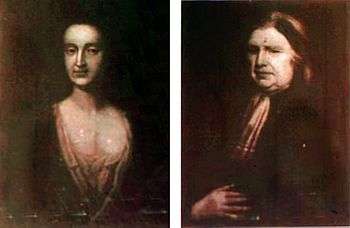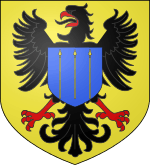Stephen Delancey

Stephen Delancey (Etienne de Lancy in French) (October 24, 1663, Caen – November 18, 1741) was a major figure in the life of colonial New York. His children continued to wield great influence until the American Revolution.
Early life
Stephen DeLancy was born in Caen, France, on October 24, 1663[1] as Etienne de Lancy, the only son of Jacques de Lancy, Esq. and Marguerite Bertrand. His great-grandfather was Jacques de Lancy, a crown prosecutor, and his 2x-great grandfather was Charles de Lancy, 5th Viscount of Laval and Nouvion.
Ancestors

%2C_ch%C3%A2teau_et_balustrade_XVIe_et_XVIIe_s.%2C_class%C3%A9s_M.H..jpg)
The de Lancy family were minor French nobility ("Noblesse de France Royale") and, despite being of the Huguenot faith, served the French Crown as administrators and bureaucrats for over two hundred years. Dating back to the early 15th century, successive generations of the de Lancy family (or de Lanci in elder texts) held the titles of Viscount of Laval and of Nouvion, Baron of Raray, Lord of Nery and of Faverolles, Verines, Ribecourt and Haramont. (Vicomte de Laval et de Nouvion, Baron de Raray, et Seigneur de Néry et de Faverolles, Vérines,[2] Ribécourt, et Haramont) The family coat of arms is described as follows: Arms: Or with Sable Eagle beaked and membered of Gules charged in the heart of an escutcheon of Azure overloaded with three spears of Or raised in pale. (Armes : d'or à l'aigle de sable becqué et membré de gueules chargé en coeur d'un écusson d'azur surchargé de trois lances d'or posées en pal.)
Jacques De Lancy, was descended from Guy de Lancy (d. 1436), the 1st Viscount of Laval and of Nouvion, which was created in 1432 during the reign of Henry VI. Guy was succeeded in 1436 by his son, Jean de Lancy, 2nd Viscount. He was succeeded by his son, Jean de Lancy, 3rd Viscount (b. 1470), who was succeeded by his son, Charles de Lancy, 4th Viscount in 1525. Ten years later, in 1535, Charles was succeeded by Charles de Lancy, 5th Viscount of Laval, who was the eldest of his two sons from his second marriage to Marie de Villiers.[3] On April 15, 1534, Charles, the 5th Viscount, married Isabeau Branche, daughter of Fourcy Branche, Lord of Bréau, with whom he had three sons: Charles de Lancy, Jacques de Lancy, and Claude de Lancy. The second son, Jacques, crown prosecutor in the provost, had a son Pierre de Lancy, Lord of Niville. His son, Jacques de Lancy, was the father of Etienne de Lancy.
Around 1600, the land of Raray was sold to Nicolas de Lancy, advisor to the King, war treasurer, Chamberlain of Gaston, Duke of Orléans. He built of the present castle of Raray along with the two outer buildings. In 1945, Raray Castle was the filming location for scenes from the film Beauty and the Beast by Jean Cocteau. In 1654, de Lacey was created Marquis de Néry-Raray by Louis XIV, a title which is currently held by the Marquis de la Bédoyère who married into the family.[4]
Career
Flee from France
In 1686, Etienne de Lancy was forced to flee bitter persecution by French Catholics following the October 18, 1685 revocation of the Edict of Nantes by Louis XIV, in which some two hundred thousand Huguenots left their native land. Escaping first to Rotterdam with a portion of the family jewels which his mother had given him[5] sewn into his clothing, Etienne sailed to England, obtaining an "Act of Denization" (naturalization) from King James II on March 3, 1686.
Life in New York
Soon afterwards, Etienne sailed for the English Colonies in America, landing in New York City on June 6, 1686. Almost exactly one month later (July 7), he obtained additional letters of denization in New York from Governor Dongan, and on September 9, 1687, took the Oath of Allegiance to the British Crown under the Colonial Act of 1683. It is at this time that he anglicized his name, becoming Stephen Delancey. He sold his portion of the family jewels for 300 British Pounds and became a merchant.[5]
Delancey was to become one of the most successful merchants in the colony of New York with his well-known granary, warehouse and retail store, known to all as "Delancey and Co." During Queen Anne's War, letters of marque against the French served as a cover for DeLancey to engage in trade with Red Sea Pirates. By the 1730s, he had become such a prosperous merchant that he was able to build a large mansion on Broadway, just above Trinity Church. The mansion was eventually demolished in 1792 to build the City Hotel, and the site is now occupied by the Boreil Building.
Stephen Delancey played an active role in the life of the city, serving as an Alderman[1] for several years, and both a member of the New York Provincial Assembly and the Governor's Council.[1] He is also credited with having presented as gifts to the city its first Town Clock and its first Fire Engine.
Family
On January 23, 1700, Delancey married Anne van Cortlandt (1676-1724), third child of Chief Justice of the Province of New York Stephanus van Cortlandt (1643–1700), and his wife Gertrude Schuyler (b. 1654). They had ten children, only five of whom survived infancy, all of whom married and had issue. They were:
- James DeLancey (1703–1760), who married Anne Heathcote
- Peter DeLancey (1705–1770)
- Susannah DeLancey (1707–1771), who married Admiral Sir Peter Warren (1703–1752)
- Oliver DeLancey (1718-1785), who married Phila Franks
- Anne DeLancey (1723–1784), who married John Watts (1715–1789), a prominent businessman of the day.
In the summer of 1700, Delancey began construction of a house at 54 Pearl Street in New York City, on land given to his wife by her father as a wedding gift to the young couple. In 1762, the house was sold at auction by Stephen's heirs to Samuel Fraunces, who converted it into the Queen Charlotte Tavern. The house still stands today, and is known as Fraunces Tavern.
At the time of his death on November 18, 1741, the erstwhile immigrant Etienne de Lancey left an estate valued in excess of £100,000 British Pounds (approximately $18,000,000 in US Dollars today).
Descendants
James became Chief Justice of the Supreme Court for the Province of New York, in addition to serving as Lieutenant Governor of New York. Peter became a merchant, maintaining a large mill in what is now the Bronx, and served in the New York Provincial Assembly for many years. Oliver, also a merchant, became a Brigadier General in the British Army during the American Revolution.
His grandson, John Watts (1749–1836), was a lawyer and politician from New York City who represented New York in the U.S. House of Representatives.[6]
There is a Bahamian branch of the De Lancy family through De Lancy's grandson, Stephen DeLancey, from his time as Chief Justice of the Bahamas.[1]
Footnotes
- 1 2 3 4 Kenneth T. Jackson: The Encyclopedia of New York City: The New York Historical Society; Yale University Press; 1995. P. 324.
- ↑ http://charlesfevre.perso.sfr.fr/genealogie/page_nery.htm
- ↑ The 4th Viscount's second son was Christophe de Lancy, Lord of Raray.
- ↑ "L'Histoire de Raray". www.raray.fr. Mairie de Raray. Retrieved 15 September 2016.
- 1 2
 Wilson, James Grant; Fiske, John, eds. (1900). "De Lancey, Étienne". Appletons' Cyclopædia of American Biography. New York: D. Appleton.
Wilson, James Grant; Fiske, John, eds. (1900). "De Lancey, Étienne". Appletons' Cyclopædia of American Biography. New York: D. Appleton. - ↑ Stevens, Walter Barlow (1921). Centennial History of Missouri, Vol. 2, 1921. Chicago : S.J. Clarke Pub. Co. p. 76.
References
- D.A. Story, The de Lancey's: Romance of a Great Family, Toronto: Nelson & Sons, 1931.
- George Lockhart Rives: Genealogical Notes (New York: Knickerbocker, 1914).